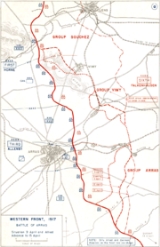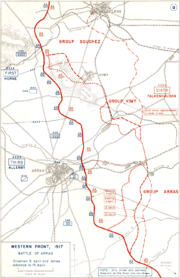
Carrière Wellington
Encyclopedia
The Carrière Wellington is a museum
in Arras
, northern France
. It is named after a former underground quarry which was part of a network of tunnels used by forces of the British Empire
and Commonwealth during the First World War. Opened in March 2008, the museum commemorates the soldiers who built the tunnels and fought in the Battle of Arras
in 1917.
 From the Middle Ages
From the Middle Ages
through to the 19th century, the chalk beds underneath Arras were extensively quarried to supply stone for the town's
buildings. The quarries fell into disuse by the start of the 20th century. In 1916, during the First World War, the British forces controlling Arras decided to re-use the underground quarries to aid a planned offensive against the Germans, whose trenches ran through what are now the eastern suburbs of the town. The quarries were to be linked up so that they could be used both as shelters from the incessant German shelling and as a means of conveying troops to the front in secrecy and safety.
500 miners from the New Zealand
Tunnelling Company, including Māori and Pacific Islanders, recruited from the gold and coal mining districts of the country, were brought in to dig 20 kilometres (12.4 mi) of tunnels. They worked alongside Royal Engineer tunnelling companies
, made up by now of British coal miners and expert tunnellers who had built the London Underground
. Many of them were "Bantams
", soldiers of below average height who had been rejected from regular units because they did not meet the height requirements; others had been initially rejected as too old, but their specialist mining experience made them essential for the tunnelling operation.
The work was difficult and dangerous. In the New Zealand units alone, 41 tunnellers died and another 151 were injured during countermining operations against the Germans, whose own tunnellers sought to disrupt the Allied tunneling operations. The Arras tunnels linked the quarries to form a network that ran from the town centre, under no man's land, to a number of points just in front of the German front lines. The tunnel system could accommodate 20,000 men and were outfitted with running water, electric lights, kitchens, latrines, a light rail system and a fully equipped hospital. The tunnellers named the individual quarries after their home towns - Auckland, Wellington, Nelson, Blenheim, Christchurch and Dunedin for the New Zealanders, Glasgow, Edinburgh, Crewe and London for the Britons.
Thousands of soldiers were billeted in the tunnels for eight days prior to the start of the Arras offensive on 9 April 1917. At 05:30 that morning, exits were dynamited to enable the troops to storm the German trenches. The Germans were taken by surprise and were pushed back 11 km (6.8 mi). This counted as an extraordinary success by the standards of the time. However, the offensive soon bogged down and it was eventually called off after casualties reached 4,000 a day.
During World War II
, the tunnels were re-opened to serve as air raid shelters. They were sealed again in 1945 and were largely forgotten until their rediscovery in 1990. Much of the network has now collapsed and most of the rest is extremely unsafe. With the sponsorship of the Arras town council, the regional council and the French state, one section around the Carrière Wellington was restored and converted into a museum at a cost of €4 million.
The tunnels are accessed via a lift shaft that takes visitors approximately 22 m (70 ft) below ground to the galleries around the Wellington quarry. Visitors are taken on a guided tour along some 350 m of tunnels to see audio-visual presentations of various aspects of the campaign and the soldiers who built and stayed in the tunnels. At various places, graffiti and painted signs can be seen, along with relics of the troops such as cans of bully beef, helmets and bottles.
The museum is on the Rue Arthur Deletoile, a turning off the Avenue Fernand Lobbedez (D917), approximately 1 km south of the city centre (GPS navigation may lead an unwary visitor astray).
Museum
A museum is an institution that cares for a collection of artifacts and other objects of scientific, artistic, cultural, or historical importance and makes them available for public viewing through exhibits that may be permanent or temporary. Most large museums are located in major cities...
in Arras
Arras
Arras is the capital of the Pas-de-Calais department in northern France. The historic centre of the Artois region, its local speech is characterized as a Picard dialect...
, northern France
France
The French Republic , The French Republic , The French Republic , (commonly known as France , is a unitary semi-presidential republic in Western Europe with several overseas territories and islands located on other continents and in the Indian, Pacific, and Atlantic oceans. Metropolitan France...
. It is named after a former underground quarry which was part of a network of tunnels used by forces of the British Empire
British Empire
The British Empire comprised the dominions, colonies, protectorates, mandates and other territories ruled or administered by the United Kingdom. It originated with the overseas colonies and trading posts established by England in the late 16th and early 17th centuries. At its height, it was the...
and Commonwealth during the First World War. Opened in March 2008, the museum commemorates the soldiers who built the tunnels and fought in the Battle of Arras
Battle of Arras (1917)
The Battle of Arras was a British offensive during the First World War. From 9 April to 16 May 1917, British, Canadian, New Zealand, Newfoundland, and Australian troops attacked German trenches near the French city of Arras on the Western Front....
in 1917.
History

Middle Ages
The Middle Ages is a periodization of European history from the 5th century to the 15th century. The Middle Ages follows the fall of the Western Roman Empire in 476 and precedes the Early Modern Era. It is the middle period of a three-period division of Western history: Classic, Medieval and Modern...
through to the 19th century, the chalk beds underneath Arras were extensively quarried to supply stone for the town's
buildings. The quarries fell into disuse by the start of the 20th century. In 1916, during the First World War, the British forces controlling Arras decided to re-use the underground quarries to aid a planned offensive against the Germans, whose trenches ran through what are now the eastern suburbs of the town. The quarries were to be linked up so that they could be used both as shelters from the incessant German shelling and as a means of conveying troops to the front in secrecy and safety.
500 miners from the New Zealand
New Zealand
New Zealand is an island country in the south-western Pacific Ocean comprising two main landmasses and numerous smaller islands. The country is situated some east of Australia across the Tasman Sea, and roughly south of the Pacific island nations of New Caledonia, Fiji, and Tonga...
Tunnelling Company, including Māori and Pacific Islanders, recruited from the gold and coal mining districts of the country, were brought in to dig 20 kilometres (12.4 mi) of tunnels. They worked alongside Royal Engineer tunnelling companies
Royal Engineer tunnelling companies
Royal Engineer tunnelling companies were specialist units of the Corps of Royal Engineers within the British Army, formed to dig attacking tunnels under enemy lines during the First World War....
, made up by now of British coal miners and expert tunnellers who had built the London Underground
London Underground
The London Underground is a rapid transit system serving a large part of Greater London and some parts of Buckinghamshire, Hertfordshire and Essex in England...
. Many of them were "Bantams
Bantam (military)
A bantam, in British army usage, was a soldier of below the British Army's minimum regulation height of 5ft. 3ins.During the First World War, the British Army raised battalions in which the normal minimum height requirement for recruits was reduced from 5'3" to 5'...
", soldiers of below average height who had been rejected from regular units because they did not meet the height requirements; others had been initially rejected as too old, but their specialist mining experience made them essential for the tunnelling operation.
The work was difficult and dangerous. In the New Zealand units alone, 41 tunnellers died and another 151 were injured during countermining operations against the Germans, whose own tunnellers sought to disrupt the Allied tunneling operations. The Arras tunnels linked the quarries to form a network that ran from the town centre, under no man's land, to a number of points just in front of the German front lines. The tunnel system could accommodate 20,000 men and were outfitted with running water, electric lights, kitchens, latrines, a light rail system and a fully equipped hospital. The tunnellers named the individual quarries after their home towns - Auckland, Wellington, Nelson, Blenheim, Christchurch and Dunedin for the New Zealanders, Glasgow, Edinburgh, Crewe and London for the Britons.
Thousands of soldiers were billeted in the tunnels for eight days prior to the start of the Arras offensive on 9 April 1917. At 05:30 that morning, exits were dynamited to enable the troops to storm the German trenches. The Germans were taken by surprise and were pushed back 11 km (6.8 mi). This counted as an extraordinary success by the standards of the time. However, the offensive soon bogged down and it was eventually called off after casualties reached 4,000 a day.
During World War II
World War II
World War II, or the Second World War , was a global conflict lasting from 1939 to 1945, involving most of the world's nations—including all of the great powers—eventually forming two opposing military alliances: the Allies and the Axis...
, the tunnels were re-opened to serve as air raid shelters. They were sealed again in 1945 and were largely forgotten until their rediscovery in 1990. Much of the network has now collapsed and most of the rest is extremely unsafe. With the sponsorship of the Arras town council, the regional council and the French state, one section around the Carrière Wellington was restored and converted into a museum at a cost of €4 million.
Museum
The Carrière Wellington museum consists of a visitor centre displaying historic artifacts and presenting the historical context of the Battle of Arras, including the work of the tunnellers and the military strategy that underlay the tunnels' construction. It was opened to the public on 1 March 2008.The tunnels are accessed via a lift shaft that takes visitors approximately 22 m (70 ft) below ground to the galleries around the Wellington quarry. Visitors are taken on a guided tour along some 350 m of tunnels to see audio-visual presentations of various aspects of the campaign and the soldiers who built and stayed in the tunnels. At various places, graffiti and painted signs can be seen, along with relics of the troops such as cans of bully beef, helmets and bottles.
The museum is on the Rue Arthur Deletoile, a turning off the Avenue Fernand Lobbedez (D917), approximately 1 km south of the city centre (GPS navigation may lead an unwary visitor astray).
External links
- Carrière Wellington (official website)
- - Information on the Carrière Wellington from La Voix du Nord (in French)

